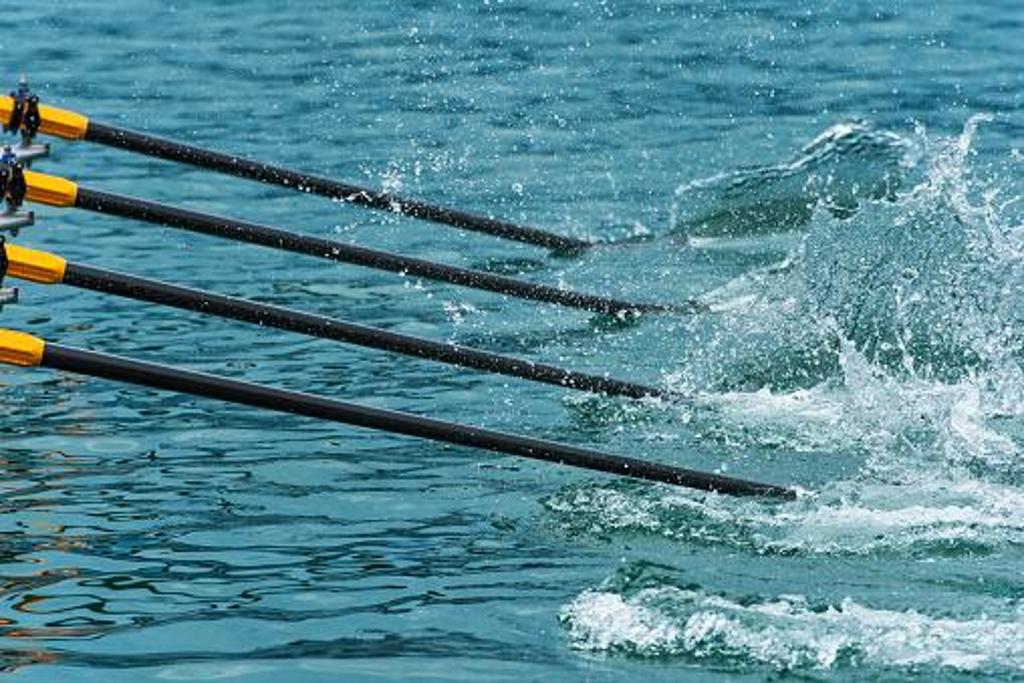Rowing Basics and Terminology

The sport of rowing goes back to antiquity, but modern rowing as we know it dates to the 1700s. It first gained widespread popularity in England (where the Henley Royal Regatta began in 1839 and continues to this day), before spreading to America and around the world. The word “crew” is a nautical term long associated with boating, and it speaks to the teamwork and synchronicity that are hallmarks of the sport.
Rowers usually engage in sculling (where they wield two oars) or sweeping, where rowers have a single oar and are equally balanced on both sides of the boat. The eight-person racing shell, usually referred to simply as an “8,” with four oars on the port side and four on starboard, is the best-known configuration in crew.
Rowers row backwards, facing the stern, with only the coxswain (pronounced “cox’n” and frequently shortened to “cox”) facing forward to see the course ahead. Seats are numbered according to their place in the boat, with 1 seat at the bow up through 4 or 8 at the stern, depending on the boat.
Rowing is a physically demanding sport that provides full-body conditioning. According to U.S. Rowing, the sport's governing body, rowing demands "virtually everything a human being can physically bring to an athletic competition -- aerobic ability, technical talent, exceptional mental discipline, ability to utilize oxygen efficiently and in huge amounts, balance, pain tolerance, and the ability to continue to work when the body is demanding that you stop."
In Arlington, Virginia, high school rowing began in 1949 under the guidance of legendary local coach Charlie Butt. Although Wakefield boasted a short-lived crew team in the 1950s, the team re-formed in earnest in 1991, and its popularity and success have grown ever since. The team has earned numerous medals in local, regional, and national races, culminating in its 2022 men's and women's sweep of the Virginia State Rowing Championships. In addition to other successes, the girls 1V defended their state champion title for the third year in a row in 2023.
Today, Wakefield Crew athletes compete in 8s and 4s, although sometimes rowers will compete in other configurations at the coaches' discretion. Wakefield hosts its own regatta, District Sprints, in late March, and participates in several regattas hosted by the Virginia Scholastic Rowing Association (VASRA) on the Occoquan River.

Common Rowing Terms
4+ or 8+: The number refers to the number of seats, and the + indicates that a coxswain is on board. A 4x is a quad, meaning the rowers are sculling instead of sweeping.
Blade: The part of the oar that enters the water and pushes the boat forward.
Bow: The forward section of the boat and the first to cross the finish line.
Catching a crab: When an oar gets stuck in the water and either slows down or stops the boat. All rowers dread crabs, but all experienced rowers have caught them.
Coxswain (pronounced "cox'n" and often shortened to "cox"): The non-rowing crew member who steers the shell and who provides information and motivation during races via a “cox box.”
Ergometer or erg: A stationary rowing machine.
Gunwales (pronounced “gunnels”): The top edge or rim of the shell.
Oar: This is the tool by which rowers advance the boat, usually about 12 feet long.
Oarlock: The lock that attaches the oars to the riggers.
Port: As in all types of boating, port refers to the left side of the boat in the direction of movement. Because rowers sit backwards in a shell, however, port is on a rower’s right side.
Rigger: The triangle-shaped mechanisms in which oars are locked. “Rigging the boat” means affixing these items to the boat; “derigging” often happens to make boats easier and safer to transport to regattas.
Rowing stroke: Parts of the rowing stroke include the catch, finish, feather, and recovery. The catch is the moment the blade enters the water and the finish is where it exits. Feathering is when the blade is moving parallel to the water in the recovery phase of the stroke, as the rower prepares to repeat the process.
Sculling: Rowing with two oars, one in each hand, as opposed to sweeping, where each rower has one oar.
Shell: The boat, which can be of varying lengths, seats, and even rigging configurations.
Slide: The track on which the rowers' seats slide back and forth.
Split: How long it takes a rower to row 500 meters at their current speed; the lower the split, the faster you’re rowing.
Starboard: As in all types of boating, starboard refers to the right side of the boat in the direction of movement. Because rowers sit backwards in a shell, however, starboard is on a rower’s left side.
Stern: The back of the boat, and the last part to cross the finish line.
Stretchers or foot-stretchers: The place where rowers put their feet, with permanent shoes affixed to the footrests. This is why rowers remove their shoes and enter the boat in socks.
Stroke rate: The number of strokes per minute. Power and speed can be generated even at lower stroke rates, but generally sprints involve higher stroke rates.
Stroke seat: The rower who sits closest to the stern (and the coxswain) and who sets the rhythm for the other rowers to follow.
Sweeping: Rowing with one oar, as opposed to sculling, which is rowing with two oars.
Way enough: The universal rowing command to stop rowing on the water or to stop moving on land (usually when carrying the boat). Sometimes spelled "weigh enough" or "way 'nuff."






